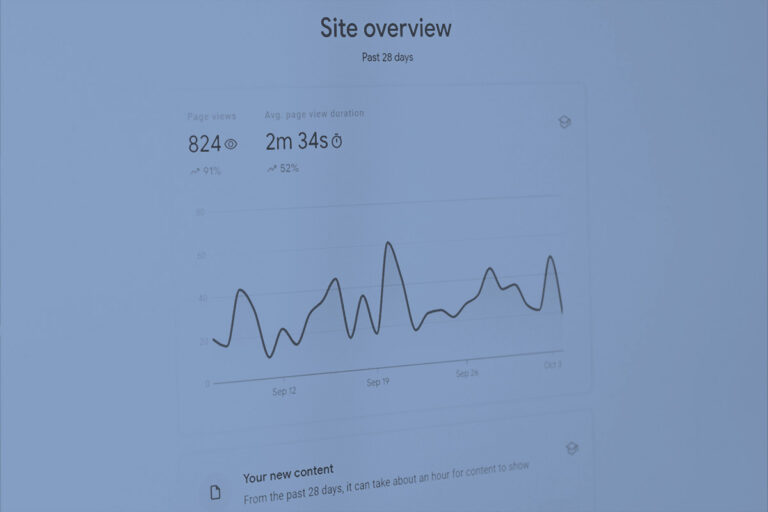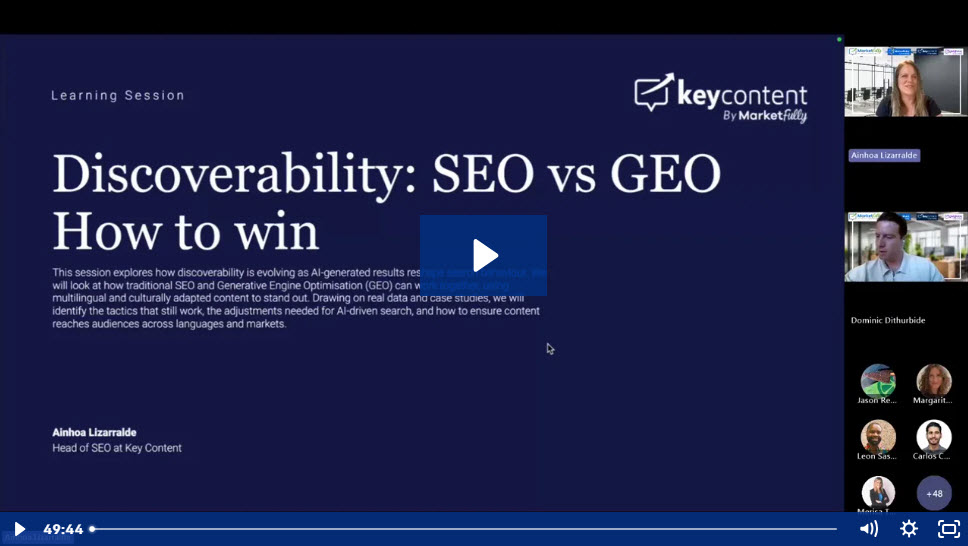The way people find the content they’re looking for and how they interact with search engines is changing, thanks to AI-powered search. Rather than scrolling through organic links, like we did just a few years ago, the first thing users see on most searches is usually a single AI-generated answer that combines information from a wealth of sources. The biggest question you have to answer for your brand is, are you showing up in those answers? Ranking well in traditional SEO isn’t enough anymore. Your pages must be cited by AI engines to gain AI visibility.
AI search results are also highly volatile, with some studies reporting that about 40 – 60% of the domains cited by AI answers change from month to month. Google AI Overviews tend to turn over even faster, with roughly 70% of sites featured in an Overview changing within two or three months. So, even if you’re ranking well in classic search, your AI visibility might still fluctuate wildly.
To succeed in 2025, you need a plan to test, optimise, and track your AI search presence, and this guide gives you a practical checklist to do exactly that. You’ll deal with step-through testing your current AI visibility, optimising your content for generative search (GEO), using tools to monitor AI citations, and setting up ongoing reporting. Let’s get started.
Step 1: Test your website’s AI visibility
Before you start optimising, you need to know where your site stands in AI results. Follow this step-by-step test:
- Pick key topics or queries. Start with the main keywords and questions your audience cares about. For example, if you sell marketing software, you might choose prompts like “best CRM for small businesses” or “compare [Your Product] to [Competitor]”. Include broad keywords and more specific question phrases.
- Query multiple AI tools. Try out ChatGPT (or Bing Chat), Google’s AI features, and Perplexity. For Google AI, search the query in Google and look for an AI Overview or AI Answers box. For ChatGPT (GPT-4 or 4oice), ask your questions directly, ideally phrasing them as instructions (e.g. “List the steps to do X, and cite your sources.”). Perplexity and similar answer engines often provide direct citations. The goal is to see if the answers include your brand or content.
- Record the results. For each query and tool, note what answer you get and whether your site is mentioned or cited. Copy snippets or screenshots. Pay attention to the source links the AI shows. If an AI answer cites a source (like a URL) where your content appears, mark it down. Also, make a note if AI pulls information from competitors instead.
- Use a tracking table. To organise this, create a simple table. For example:
|
Query/Prompt |
AI Platform | Answer Summary. Does it mention your content? |
Cited Source URL |
| “What are the top CRM tools for X?” | Google AI Overviews | Mentions tools A, B, C. (Our site not cited.) | ✗ |
| “Explain [Your Product] vs Competitor” | ChatGPT (GPT-4) | Lists key features and cites Wikipedia [Y]. (Our blog was not cited.) | ✗ |
| “How to solve [customer problem]” | Perplexity.ai | Cites an industry blog including our guide. | ✓ [ourguide.com/guide] |
Update this weekly or monthly. Because answers change often, seeing trends, like your site gradually appearing more in ChatGPT over time, is more useful than any one result.
Analyse what you find. Look for patterns and ask questions.
Are you never cited?
Which competitors show up instead?
Is your site visible in some tools but not others?
This tells you where to focus. For instance, if ChatGPT consistently ignores you but Google AI sometimes cites you, you might need to boost your answer-ready content to win over the chatbots.
This can help you understand how AI sees your content and where there are gaps. It’s the first step to improving AI visibility.
Step 2: Optimising Content for GEO
Once you know where you stand, use this checklist to improve your content’s AI readiness. Each point addresses a way AI search looks at content:
Cover the full customer journey
Create content for every stage, from general awareness to buying guides, because AI answers might draw from any relevant page. Include helpful overview articles (e.g. “What is X?”), in-depth guides, and how-to posts that answer user questions at all levels, so AI can grab info no matter the query.
Give short answers and key takeaways
AI loves concise, complete answers. At the start of each article, include a TL;DR or bullet-list summary of the main points. This “quick answer” box should stand out to users, so label it a “Key Points” or “Summary”. You can also insert mini-summaries before long sections to tell the AI where the direct answer is. Short tables and bullet lists can act like mini-snippets, too.
Show your expertise (E-E-A-T)
Your site MUST signal trust. Always include author bylines or contributor info, with any credentials or real-world experience. Cite data sources and link out to reputable references, like studies, news, Wikipedia, etc. Google’s guidelines and industry experts tell us that experience, expertise, authority and trustworthiness (E-E-A-T) still matter today.
Keep your content clear
Use clear headings and a logical layout, so both people and AI can skim your content easily. Organise each page with an H1 title, H2 subheadings, etc. In fact, phrase H2/H3 headings as actual questions or query phrases when possible. For example: instead of “Our Services”, use “What Services Does [Brand] Offer?”. Chunk your text into short paragraphs and bullet lists. Use semantic HTML for lists and highlights. Remember: a heading like “How X Works” followed by a direct answer is exactly the kind of thing AI loves.
Localise for the user
For B2B and e-commerce, you’ll need to think globally and locally. If you serve multiple regions, add local terms and examples to your content to help it resonate locally. Mention cities, countries, currencies, and local use-cases as appropriate. Make sure your Name-Address-Phone (NAP) data is consistent across your site and Google Business profile. Participate in local Q&A or forums, like industry boards, so AI tools can pull local trust signals. Also, consider translating or tailoring content according to region and language.
Refresh and update regularly
With AI pulling from up-to-date data, pages that are stale or stagnant will usually lose visibility. Set a schedule to revisit and update your key pages. Add new insights, statistics, or industry changes at least every few months. Even republishing or maintaining a “Last updated” note can help show AI that your info is fresh.
Follow basic SEO fundamentals
Remember that GEO builds on SEO. Keep your site crawlable with good technical SEO, fast mobile pages, and HTTPS, because AI tools still need to find and read your content.
Writing for AI is the modern twist on “write for people first”, because AI is becoming the first “person” answering questions online.
Step 3: Tracking performance across markets
If you want to measure how well your content is performing, you’ll need to blend AI insights with old-school SEO tools. Here’s how to track across markets.
Google Search Console (GSC)
Keep using GSC for organic search data. Look out for the new AI elements, like Google now tagging AI Overviews in performance reports (you’ll see an “AI” icon in some cases). Google’s 2025 update merges GSC and Google Analytics 4 (GA4) into one dashboard, otherwise known as GSC Insights. This unified view shows clicks, impressions, and even trending queries in an easy format. You can filter by country or device to see how content performs in different markets.
Google Analytics 4 (GA4)
Use GA4 to see what happens after the click. Monitor engagement and conversions on pages that AI drives traffic to. You might not see “AI search” explicitly, but you can tag content. For example, label pages optimised for AI answers (like detailed guides) and track their traffic sources. GA4’s custom reports can break down audiences by region, source, or behaviour.
SEO Tools
Most SEO platforms now include AI data, like SE Ranking’s AI Search Toolkit, showing whether your site appears in ChatGPT and Google AI results. Semrush has an AI SEO Toolkit with share-of-voice and “AI Mode” tracking. Use these to monitor keyword visibility across AI channels. They also let you compare competitors and see which brands dominate AI answers for your key topics.
Build regular reports
Build a simple reporting plan. For example, each month report (a) Google impressions by country (GSC), (b) Traffic/conversions by page (GA4), (c) AI visibility share vs top competitors (SE Ranking/Semrush), (d) Updates made (content refreshed), and the next action items. Because AI results move fast, look for trends over time rather than week-to-week spikes. Use charts or traffic light alerts for big drops. The main point is to catch changes as quickly as possible, so if you disappear from chatbot answers, you can find the drop in your AI visibility score and investigate it.
Key Content has developed a AI Overviews dashboard to track international multilingual content performance. Contact us to see a demo.
Tools to Track AI Visibility
There’s a new category of analytics platforms that make it easy for non-technical users to see if and how their content is cited in AI-generated answers. These tools automatically query multiple answer engines like ChatGPT, Google AI Overviews/AI Mode, Perplexity, and Gemini, etc., for your key prompts. What you end up getting is an intuitive dashboard that shows prompt-level data, like which AI models cite your site, which source domains they use, and how often each mention occurs. You’ll quickly see how often your brand appears in AI answers, which websites are driving those answers, and how this changes over time.
Profound is an enterprise AI search analytics platform that falls into this category and offers an Answer Engine Insights report that tracks exactly how often your brand appears in AI answers and which sites are being cited. Profound also lets you analyse prompt volumes so you can drill down by individual queries to see how AI visibility changes for specific topics.
Major SEO suites have similarly added GEO features, including Semrush, which now offers Enterprise AIO and an AI SEO Toolkit that layers AI-specific data onto its normal reports. These track your brand’s share of voice, mention count, and even sentiment across major AI search engines. Ahrefs introduced a Brand Radar add-on with an AI visibility dashboard, which monitors how your brand appears in AI answers and emphasises actions like “find and secure valuable AI citations” across LLM platforms.
Ranking platforms onboard
Rank-tracking platforms have joined the fray as well, like SE Ranking offering an AI Overviews Tracker, which identifies which keywords trigger Google’s AI-generated Overviews and shows which domains are cited in those answers. It even provides historical snapshots to analyse how AI Overviews and sources change over time for your tracked keywords.
On the simpler side, newer dashboard-focused tools, like Peec AI, make monitoring very easy. Peec AI has an easy interface that tracks your brand’s visibility, position, and sentiment across AI assistants. Its dashboard summarises key metrics, including visibility score, rank in various AI answers, etc., without needing an SEO expert to interpret it.
Otterly is similar, and automatically monitors your site’s mentions and citations across major AI search engines like ChatGPT, Google AI Overviews/AI Mode, Perplexity, Gemini, Copilot, and so on. Otterly’s reports show your brand’s share of voice in each AI engine and which websites are being referenced in the answers.
All of these new tools serve one main purpose, to gain insight as quickly as possible.
Step 4: A reporting plan
To stay on top of AI visibility, incorporate a reporting plan and regular analytics review:
- Weekly/Monthly AI Check-ins: Even if you’re using a tool, schedule at least a monthly manual check of a few key prompts, like in the previous step. Note anything unexpected.
- Monthly KPI Dashboard: Include an “AI Visibility” line in your SEO dashboard. For example, show “Percentage of tracked queries where our site is cited in AI answers” next to organic clicks and rank position.
- Quarterly Strategy Review: Review the strategy every 3 – 4 months. Ask, did updating a page increase AI mentions? Are new topics emerging? Make sure to plan any big content overhauls or new guides.
- Alerts: Use tools that can send email alerts. If your AI share of voice suddenly drops or a competitor leaps ahead in AI answers, an alert can help you react fast.
- Cross-team sharing: Make sure global content creators and local teams see these reports. If a country report shows low AI visibility in Japan, your Japanese SEO team can adjust.
When you keep an eye on trends and correlate the results to your content changes, it’s easy to figure out what’s working and keep improving your content accordingly.
At the end of the day
As far as we know, AI-powered search is here to stay, and it rewards brands that build trust, answer clearly, and stay up-to-date. If you follow the steps outlined above, you can make sure your content doesn’t disappear into the noise. By following the above steps – testing your AI visibility, optimising content with GEO in mind, and using the right tools, you’ll make sure your content doesn’t disappear into the noise. Start by running a few AI queries today, see if your site shows up, and fill out the example table above. Then tackle the checklist items one by one.
Finally, if your organisation operates internationally or in multiple languages, remember that local and multilingual optimisation is more vital now than ever before.
Make sure your content is ready for AI and overviews by using this checklist to audit and improve your site’s AI visibility now. For expert help with international SEO, multilingual content and GEO strategy, check out Key Content’s services in multilingual SEO and content localisation.





